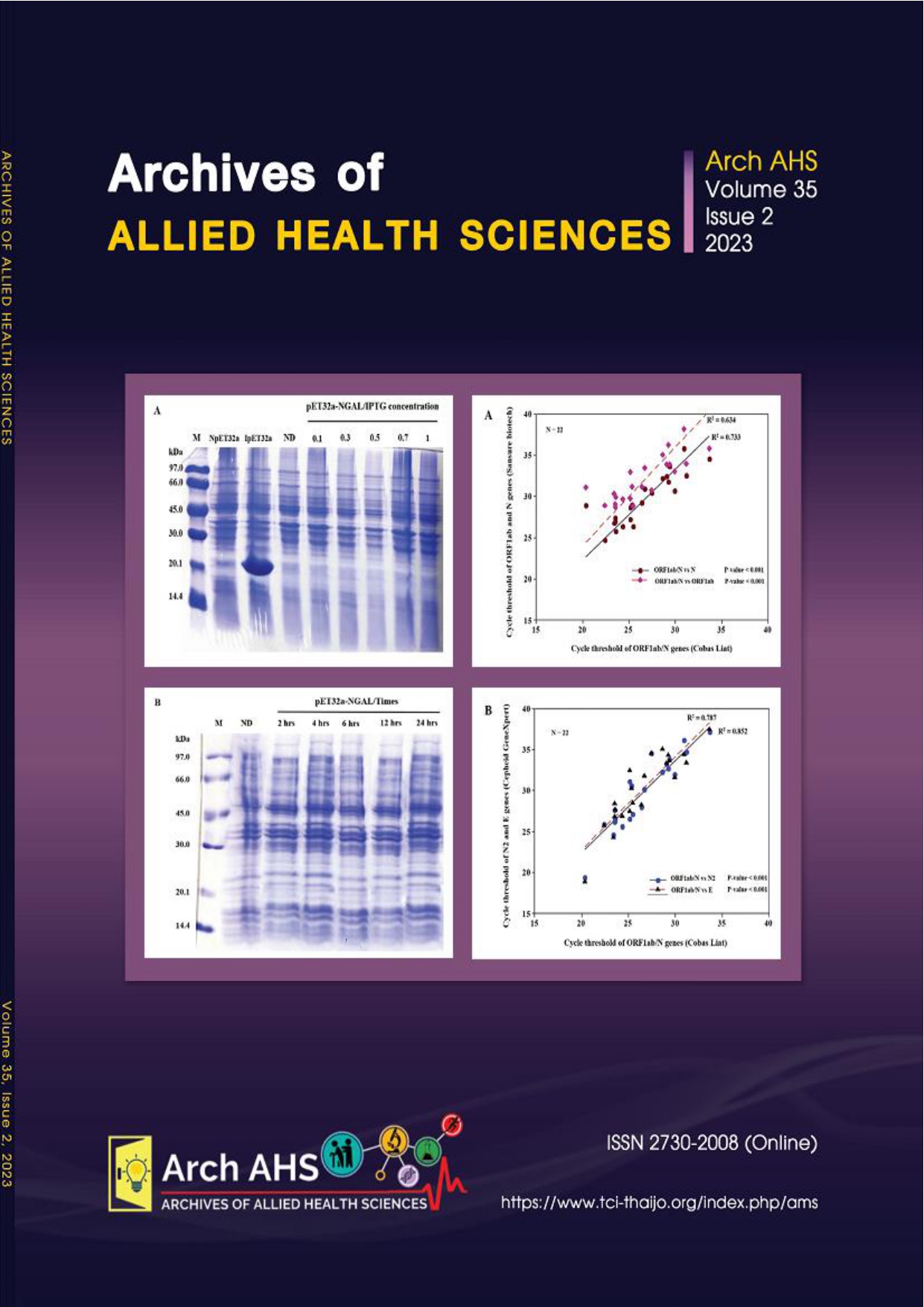Isolation, cloning and optimization for expression of neutrophil gelatinase associated lipocalin (NGAL) in prokaryote
Main Article Content
Abstract
Acute kidney injury (AKI) is a sudden loss of kidney function followed by a failure to maintain fluid, which is associated with increased mortality. Recently, neutrophil gelatinase associated lipocalin (NGAL) has been recommended as the first biomarker for prediction of kidney damage in the early phase. For medical applications of the NGAL protein, a large amount and expression system of this protein is required. Currently, the assay to determine NGAL levels is enzyme-linked immunosorbent assay (ELISA), which is accurate but inconvenient for clinical applications, because its long-time process takes about 4 hours and the antibody against human NGAL is expensive. Therefore, high-level expression of NGAL is required in order to develop a commercially NGAL strip test. The present study aimed to construct the recombinant plasmid, to optimize the expression of NGAL in Escherichia coli BL21(DE3) and OrigamiTMB(DE3) strains. The host strain, IPTG concentration and induction time were also evaluated. NGAL gene was cloned in pET32a and transformed to E. coli BL21(DE3) and OrigamiTMB(DE3). The construct of NGAL and the expression vector was successful. BL21(DE3) showed a high growth rate indicated by reaching the mid-log phase faster than OrigamiTMB(DE3). However, both E. coli BL21(DE3) and OrigamiTMB (DE3) showed no expression of NGAL. In conclusion, this study demonstrates the efficiency of the expression host to produce protein for development as a commercial strip test. The suitable system to express NGAL protein should be further investigated.
Article Details

This work is licensed under a Creative Commons Attribution-NonCommercial-NoDerivatives 4.0 International License.
References
Bellomo R, Ronco C, Kellum JA, Mehta RL, Palevsky P. Acute renal failure-definition, outcome measures, animal models, fluid therapy and information technology needs: the second international Consensus Conference of the Acute Dialysis Quality Initiative (ADQI) Group. Crit Care 2004; 8: 204-12.
Khawaja S, Jafri L, Siddiqui I, Hasmi M, Ghani F. The utility of neutrophil gelatinase-associated lipocalin (NGAL) as a marker of kidney injury (AKI) in critically ill patients. Biomark Res 2019; 7: 4.
Gaspari F, Cravedi P, Mandala M, Perico N, Deleon FR, Stucchi N, et al. Predicting cisplatin-induced acute kidney injury by urinary neutrophil gelatinase-associated lipocalin excretion: a pilot prospective casecontrol study. Nephron Clin Pract 2010; 2: 154-60.
Srisawat N, Kulvichit W, Mahamitra N, Hurt C, Praditipornsilpa K, Lumlertgul N, et al. The epidemiology and characteristics of acute kidney injury in the Southeast Asia intensive care unit: a prospective multicentre study. Nephrol Dial Transplant 2019; 1-10.
Bennett M, Catherine L, Ma Q, Dastrala S, Grenier F, Workman R, et al. Urine NGAL predicts severity of acute kidney injury after cardiac surgery: A prospective study. CJASN 2008; 3: 665-73.
Roy JP, Devarajan P. Acute kidney injury: diagnosis and management. Indian J Pediatr 2020; 8: 600-7.
Lei L, Zhu J, Xia G, Feng H, Zhang H, Han Y. A rapid and user-friendly assay to detect the neutrophil gelatinase-associated lipocalin (NGAL) using up-converting nanoparticles. Talanta 2017; 1: 339-44.
Cowland JB, Borregaard N. Molecular characterization and pattern of tissue expression of the gene for neutrophil gelatinase-associated lipocalin from humans. Genomics 1997; 45: 17-23.
Roudkenar MH, Kuwahara Y, Baba T, Roushandeh AM, Ebishima S, Ade S, et al. Oxidative stress induced lipocalin 2 gene expression: addressing its expression under the harmful conditions. J Radiat Res 2007; 1: 39-44.
Haase M, Bellomo R, Devarajan P, Schlattmann P, Haase-Fielitz A. Accuracy of neutrophil gelatinase-associated lipocalin (NGAL) in diagnosis and prognosis in acute kidney injury: a systemic review and meta-analysis. Am J Kidney Dis 2009; 6: 1012-24.
Stewart EJ, Aslund F, Beckwith J. Disulfide bond formation in Escherichia coli cytoplasm: an in vivo role reversal for the thioredoxins. EMBO J 1998; 17: 5543-50.
Studier FW, Daegelen P, Lenski RE, Maslov S, Kim JF. Understanding the differences between genome sequence of Escherichia coli B strains REL606 and BL21(DE3) and comparison of the E. coli B and K-12 genomes. J Mol Biol 2009; 394: 653-80.
Fathi-Roudsari M, Akhavian-Tehrani A, Maghsoudi N. Comparison of three Escherichia coli strains in recombinant production of reteplase. Avicenna J Med Biotechnol 2016; 8(1): 16.
Xu SY, Carlson M, Engstrom A, Garcia R, Peterson CG, Venge P. Purification and characterization of human neutrophil lipocalin (HNL) from the secondary granules of human neutrophil. Scand J Clin Lab Invest 1994; 5: 365-76.


